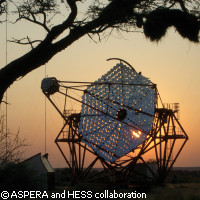Astroparticle physics unveils its 'Magnificent Seven'
Europe's astroparticle physics community has released details of its 'Magnificent Seven': major research infrastructures that will hopefully help scientists answer key questions about the nature of the universe. The seven infrastructures are listed in a new 'European strategy for astroparticle physics' produced by the EU-funded ASPERA (Astroparticle European Research Area) project. ASPERA brings together 18 national funding agencies responsible for astroparticle physics in 13 European countries. The emerging field of astroparticle physics aims to detect and study the nature of the particles that make up our universe, and their interactions with one another. It is an area of research where astrophysics, cosmology and particle physics meet. Among other things, astroparticle physicists are keen to probe the nature of dark matter, investigate the properties of neutrinos and their role in cosmic evolution, identify the origin of cosmic rays and find out more about gravitational waves. Recent years have seen major advances in the field, but answering the really big questions will require massive research infrastructures that are too expensive for any one country to build on its own. 'We are at the threshold of discoveries,' commented Christian Spiering of DESY (the German electron synchrotron), Chairman of the Roadmap Committee. At the top of the physicists' wish list is a Cherenkov Telescope Array (CTA), which would be able to detect high-energy cosmic rays. Plans for this infrastructure are already relatively advanced, and construction could start as soon as 2012. For this to happen, rapid progress needs to be made on the CTA's design and potential sites need to be selected. Another project that is at a relatively advanced stage is KM3NeT, which is also highlighted in the European roadmap for research infrastructures =produced two years ago by ESFRI (the European Strategy Forum on Research Infrastructures). KM3NeT will eventually consist of an array of optical sensors spread out over a square kilometre at the bottom of the Mediterranean Sea. The preparatory phase of KM3NeT is already underway, thanks to a grant from the EU's Seventh Framework Programme (FP7). The sensors are designed to detect neutrinos, mysterious particles that are extremely hard to detect, yet which may be responsible for our very existence. Among other things, neutrinos play an important role in causing dying stars to explode, a process that releases heavy elements into the cosmos; without these heavy elements we would not exist. Neutrinos are also the subject of two other infrastructures proposed by ASPERA. One is a special detector which would enable the study of the fundamental nature and mass of neutrinos; the other is a giant underground observatory. In addition to shedding new light on neutrinos, this underground observatory would enable physicists to look for evidence of proton decay. A design study for this infrastructure is already underway in the framework of the EU-funded LAGUNA (Large Apparatus for Grand Unification and Neutrino Astrophysics) project. Dark matter is the focus of another infrastructure on the list: although it makes up 95% of the universe, very little is known about it. According to the ASPERA partners, new, highly sensitive detectors are needed to detect and study dark matter. Finally, the strategy highlights the importance of setting up a large, underground, gravitational-wave detector. Einstein predicted the existence of gravitational waves, and although these have since been detected indirectly, no-one has yet come up with direct, experimental proof of their existence. A design study for the so-called 'Einstein Telescope', funded by FP7, is already underway. The total cost of these seven infrastructures is estimated to be at least EUR 1 billion, meaning international cooperation is crucial for their construction and maintenance. Over the coming years, the ASPERA project partners will work to build consortia of funding agencies from both inside and outside Europe to turn these ambitious plans into a reality. 'The timely realisation of the Magnificent Seven is a big challenge,' said ASPERA Coordinator Professor Stavros Katsanevas of France's National Scientific Research Centre (CNRS). 'But we are confident that none will be killed, contrary to what happens in the film, as the European agencies and ApPEC [Astroparticle Physics European Coordination] support these priorities and the same also emerge on other continents. It is important that we coordinate and share costs not only inside Europe but on a global scale.' The construction of the most advanced projects could start in as little as four years' time. Furthermore, many of the infrastructures listed consist of arrays of sensors or detectors, and as such can start working as soon as a small number of instruments are in place. As more sensors are added, the array's sensitivity will increase. The ASPERA project is financed through the 'Coordination of research activities' budget line of the Sixth Framework Programme (FP6).



